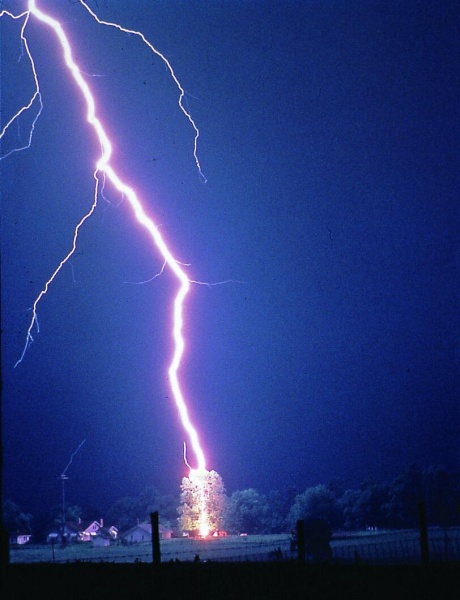
1 August 2012
Now that it’s August we’ve safely passed the month with the most lightning-related deaths and injuries.
July wins that award because it has the most thunderstorms and the storms are sneaky, popping up suddenly rather than arriving with a front in an orderly fashion. Forecasters can’t predict the timing of these pop-ups; they can only tell us they’re likely. And so we unintentionally take chances outdoors.
The photo above shows what happens when lightning strikes a tree. Sadly, just over a week ago a nine-months pregnant Amish woman was killed by lightning in Somerset County when she took shelter under a tree. Her husband and children were under a different tree and were unharmed — a cruel fate for all involved.
Fortunately, death by lightning is a rare occurrence. 90% of the people struck by lightning survive, but they are often injured for life. Lightning damages the body’s electric grid — the nervous system — so the chronic pain, brain-injury and post-concussion-type symptoms can be very mysterious and seem unrelated to lightning. Steve Marshburn was so frustrated by how little his lightning ailments were recognized that he started Lightning Strike and Electric Shock Survivors International which holds an annual conference for survivors and their families.
I’m not sure if Shenandoah National Park Ranger Roy C. Sullivan ever attended but he did win the dubious honor of being the person struck most often by lightning who survived the ordeal. He was struck seven times. Here’s his story from Virginia Thunderstorms and Lightning by Barbara Watson, originally on the NOAA website.
"June 26, 1977: Park Ranger Roy C. Sullivan worked many years at Shenandoah National Park. On this day, Roy was struck by lightning for the seventh time earning him the title of "the human lightning conductor." The first time occurred in 1942 as he was working up in a lookout tower. The lightning bolt caused him to lose his big toe nail. In 1969, he was driving along a mountain road when the bolt struck. (Cars and trucks will not protect you if the window is open). He lost his eye brows. In 1970, he was walking across his yard to get the mail when lightning struck. His shoulder was seared. In 1972, he was standing in the office at the ranger station when lightning set his hair on fire. In 1973, after his hair had grown back, he was struck again. His hair was again set on fire and his legs were seared. In 1976, while checking on a campsite, he was struck injuring his ankle. His last and seventh encounter was while fishing. Lightning caused chest and stomach burns. It is not only amazing that Roy was injured seven times by lightning, but it is astounding that he was not killed! His death in his 70's was not related to lightning. He committed suicide. It was never determined why lightning seemed to be attracted to him."
This month we’ll have a little less lightning, but we’re not out of the woods yet. There are thunderstorms in our future. Be careful.
(photo in the public domain from Wikimedia Commons. Click on the image to see the original)
p.s. We had impressive lightning in the middle of the night (1 August 2012) — so impressive it woke me up.